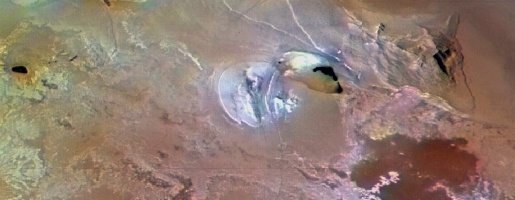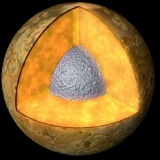 |
|||
|
Io's
volcanic vents and lava flows - surface evidence of the interior's tidal
heating.
|
|||
| THE INTERIOR OF IO | |||
| Since the Voyager mission, Io's mass and density have been known with some accuracy. Therefore, models of its interior have been more confident than those of the other Galilean satellites. | |||
| The mass and density of Io are very nearly the same as our Moon. It seemed possible that Io was a cold and dead planet too. However, even before the arrival of Voyager at Jupiter, some scientists had predicted that Io's interior would be heated by tidal forces resulting from its position within the Galilean system. Jupiter's moons Io, Europa and Ganymede are fixed in a resonant orbit. This means that for every two orbits of Io, Europa orbits once. For every two orbits of Europa, Ganymede orbits once. | |||
| Io is stretched in opposing directions when it lies directly between Europa and Jupiter. As the alignment changes, the pull diminishes and Io relaxes. These tides knead Io like a piece of dough. The stresses generate a large amount of heat, more than enough to melt the interior and drive Io's fierce volcanism. | |||
| Galileo data confirms that Io has a two main layers. Io has a large dense metallic core probably made of iron and iron sulphide. The core's radius (900 kilometres) is half Io's total radius. Small deviations in Galileo's orbit were attributed to the influence of Io's magnetic field (the first detected around a planetary satellite). | |||
 Cross-section through Io. |
|||
| Above the core is a mantle of partially molten silicate rock. The different types of volcanic activity observed on Io suggest that the crust varies from place to place. Unlike the other Galilean satellites the surface of Io is not icy. At temperatures near to Jupiter ice is not stable and Io with its thin atmosphere and weak gravity is unable to retain water vapour. | |||
| Lacking ice, and with a molten silicate interior Io has more in common with the terrestrial planets (Earth, Mars, Venus) than the icy satellites of the outer Solar System. Io is easily the most geologically active body in the Solar System. Allowing for its size Io is far more volcanically active than Earth. It is less than a 40th of Earth's volume, but it generates twice as much heat. | |||
|
|
|||